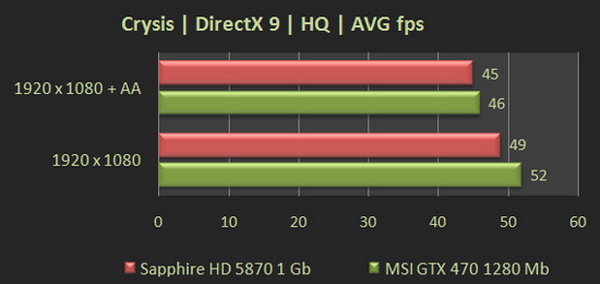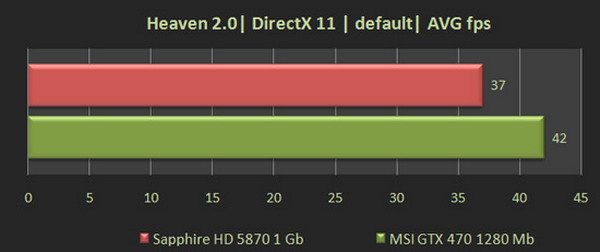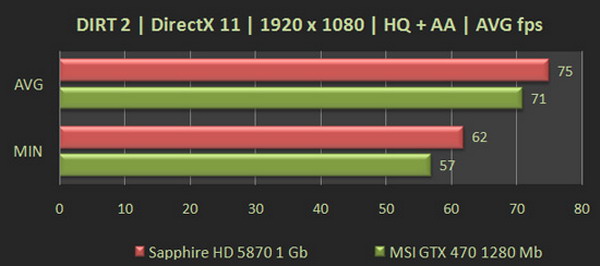
ATI Radeon HD 5870 1GB
Hardware 0 CommentsIntroduction
DirectX 11 is the DirectX 10 that never was. It’s coming out with a version of Windows that people are eager for, there are games available and games upcoming that support it, and ATI has the hardware and NVIDIA’s got rumors about theirs being a day late and a dollar short.
And there’s more than just gamers excited about it. Along with DirectX 11 comes Direct Compute, a parallel-processing platform that makes CUDA look, to be polite, ahead of its time. Tessellation, multi-GPU, free anti-aliasing, physics, all these things come with DirectX 11, and, quintessentially, with HD 5870. And look, they’re available! Theoretically, anyway. (Unavailable at the time of posting.)
Just to sweeten the deal, the price dropped just a day ago, too. What was a game-changer for a tidy $400 is now being listed at $380. OK, so it’s not mind-blowing, but looking at these benchmarks, it’s a friendly nod from the red direction.
I’ll get into the implications down the road. On to the scores:
The Card & Bundle
This is a full-length card. That?s one thing to know and another to see in a case, hanging over the edge of the motherboard by over an inch. Surprisingly, it’s very light. Both the heatsink and the card itself weigh less than an HD 4870, and there are many other differences.
The power connectors point out the front of the card, not the top. Because there are four video connections, two DVI, HDMI, and one DisplayPort, a considerable amount of the dual-slot rear of the card is blocked off, requiring that the card vent some of its heat out the top, into the case. This top vent shares real estate with the CrossFire connectors, which may constrict it depending on how taut the bridge must been in any given configuration. The component, or underside of the card is protected, and presumably cooled, by a thin heatspreader
This is a stock-clocked reference design in all other respects, and bears no branding.
Specifications and Setup
In this review, we’ll be comparing the Radeon HD 5870 to:
- ZOTAC GeForce GTX 295 1792MB
- ZOTAC GeForce GTX 285 1GB AMP
- VisionTek Radeon HD 4870 X2 2GB Redux
- Diamond Radeon HD 4870 1GB
- Sapphire Radeon HD 4650 512MB
Test Computer Specifications
- Processor: Intel Core 2 Duo E8400 3GHz
- Motherboard: Asus Rampage Formula
- Memory: Crucial Ballistix Tracer DDR2 800 @ 4-4-4-12 (Sponsored by Crucial
- Power Supply: Thermaltake Toughpower 1000 (Sponsored by Thermaltake)
- Operating System: Windows Vista Ultimate x64 (Sponsored by Microsoft)
Video Card Specifications
- From AMD 2.15 billion 40nm transistors
- TeraScale 2 Unified Processing Architecture
- 1600 Stream Processing Units
- 80 Texture Units
- 128 Z/Stencil ROP Units
- 32 Color ROP Units
- GDDR5 interface with 153.6 GB/sec of memory bandwidth
- PCI Express 2.1 x16 bus interface
- DirectX’ 11 support
- Shader Model 5.0
- DirectCompute 11
- Programmable hardware tessellation unit
- Accelerated multi-threading
- HDR texture compression
- Order-independent transparency
- OpenGL 3.2 support1
- Image quality enhancement technology
- Up to 24x multi-sample and super-sample anti-aliasing modes
- Adaptive anti-aliasing
- 16x angle independent anisotropic texture filtering
- 128-bit floating point HDR rendering
- ATI Eyefinity multi-display technology2,3
- Three independent display controllers
- Drive three displays simultaneously with independent resolutions, refresh rates, color controls, and video overlays
- Display grouping
- Combine multiple displays to behave like a single large display
- ATI Stream acceleration technology
- OpenCL 1.0 compliant
- DirectCompute 11
- Double precision floating point processing support
- Accelerated video encoding, transcoding, and upscaling4,5
- Native support for common video encoding instructions
- ATI CrossFireX? multi-GPU technology6
- Dual, triple, and quad GPU scaling
- Dual-channel bridge interconnect
- ATI Avivo HD Video & Display technology7
- UVD 2 dedicated video playback accelerator
- Advanced post-processing and scaling8
- Dynamic contrast enhancement and color correction
- Brighter whites processing (blue stretch)
- Independent video gamma control
- Dynamic video range control
- Support for H.264, VC-1, and MPEG-2
- Dual-stream 1080p playback support9,10
- DXVA 1.0 & 2.0 support
- Integrated dual-link DVI output with HDCP11
- Max resolution: 2560×160012
- Integrated DisplayPort output
- Max resolution: 2560×160012
- Integrated HDMI 1.3 output with Deep Color, xvYCC wide gamut support, and high bit-rate audio
- Max resolution: 1920×120012
- Integrated VGA output
- Max resolution: 2048×153612
- 3D stereoscopic display/glasses support13
- Integrated HD audio controller
- Output protected high bit rate 7.1 channel surround sound over HDMI with no additional cables required
- Supports AC-3, AAC, Dolby TrueHD and DTS Master Audio formats
- ATI PowerPlay’ power management technology7
- Dynamic power management with low power idle state
- Ultra-low power state support for multi-GPU configurations
- Certified drivers for Windows 7, Windows Vista, and Windows XP
Speeds & Feeds
- Engine clock speed: 850 MHz
- Processing power (single precision): 2.72 TeraFLOPS
- Processing power (double precision): 544 GigaFLOPS
- Polygon throughput: 850M polygons/sec
- Data fetch rate (32-bit): 272 billion fetches/sec
- Texel fill rate (bilinear filtered): 68 Gigatexels/sec
- Pixel fill rate: 27.2 Gigapixels/sec
- Anti-aliased pixel fill rate: 108.8 Gigasamples/sec
- Memory clock speed: 1.2 GHz
- Memory data rate: 4.8 Gbps
- Memory bandwidth: 153.6 GB/sec
- Maximum board power: 188 Watts
- Idle board power: 27 Watts
DirectX 10 Titles
Performance Notes
The thing to pay attention to here is that the HD 5870 performs as well as, if not better than, previous-generation dual-GPU cards. The truth is that at these resolutions and levels of anti-aliasing, it’s not enough to sweat this hardware. Crysis shows the real difference, and the 5870 sets a new best.
DX9, OpenGL, and Synthetics
Performance Notes
Here things slip. Not because of the card, but because these mainstream settings just aren’t enough to let the GPU pick up speed; it’s wholly bottlenecked by the CPU. Synthetic benchmarks are the thing to pay attention to, again, pointing out that a single 5870 is a step up from a 4870 X2 and just a hair shy of a GTX 295.
Video, Power, and Overclocking
Perfect video playback for a first. I didn’t notice the regular moire I’ve become accustomed to with ATI hardware, presumably because of the improved UVD2. Also, something to stick in their hat is the ability to decode two simultaneous HD streams. Previously, ATI hardware could only decode one HD plus one SD video. Although I’m sure the people who are clamoring to watch two Blu-Ray movies at once are few and far between.
If you were wondering why I’d ever bother to compare an HD 5870 to an HD 4650, this is why: at idle, the 5870 requires the same amount of power as a budget, entry-level card from the previous generation. Even NVIDIA, with its low idle power, doesn’t impress like this.
So of course, while drawing 25W, this is a quiet video card. Like, you won’t notice it quiet. How is it when it’s pulling seven times that and then some? Seriously, I thought it had to be melting, because it only spins up to about optical drive noise levels. So to see it floating around 70 degrees Celsius makes me wonder what great insight they had with their heatsinks.
Not that great cooling means great overclocking. Filled with the promise of better VRMs (the GPU has direct monitoring of the VRMs and will prevent them from over-volting on the fly, which is one of the great causes of memory hassles when overclocking) and therefore, better performance, I hoped for more. Perhaps it’s just my card, but I only got a 40MHz GPU bump and a 90MHz memory bump, so a 6% overall gain. Almost not worth trying.
Conclusion
Better adaptive anti-aliasing, better video playback, better performance, and priced in reach for anyone who wants one–seriously, for less than four hundred dollars, given how cheap everything else is now, anyone can afford it–the HD 5870 is the card to get for gaming performance, performance/ watt, low noise… there’s a whole host of good reasons.
For people looking for a valid, future-proof option, DX 11 and Direct Compute are open standards that will serve for a good long time, and for home theater types, HDMI 1.3a finally brings lossless audio across the board. And that EyeFinity jazz is pretty sexy. What’s the hang-up?
This might actually be too much video card. It’s certainly not mainstream and at 1680×1050, even with anti-aliasing cranked up, this card is bottlenecked by average hardware. If you’re looking to replace just your video card and get screaming performance, consider the 5850, due shortly. This hardware’s best fitted with a shiny new i5, i7, or Phenom II rig, and even then, those clocked high. And you know the price is going to come down when NVIDIA rolls out their DX11 hardware, if you don’t mind waiting for it.
That said, this single-GPU card matches or beats the last generation?s dual-GPU setups, and tops them all feature-wise. Which at its price, gets it props.
Coming up: the HD 5870, at high-res, high AA, and with Windows 7.















